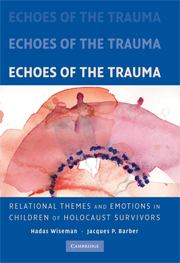Book contents
- Frontmatter
- Contents
- Foreword by Dan Bar-On
- Preface
- Acknowledgments
- 1 Introduction – A Narrative Approach to Bridging the Gap between Clinical Case Studies and Empirical Research on Children of Holocaust Survivors
- 2 Studying Relationship Narratives with the Core Conflictual Relationship Theme Method
- PART ONE RELATIONAL THEMES IN THE NARRATIVES
- PART TWO EMOTIONS IN THE NARRATIVES
- PART THREE HEALING TRAUMA IN THE CHAIN OF THE GENERATIONS
- Appendix
- References
- Index
PART TWO - EMOTIONS IN THE NARRATIVES
Published online by Cambridge University Press: 29 July 2009
- Frontmatter
- Contents
- Foreword by Dan Bar-On
- Preface
- Acknowledgments
- 1 Introduction – A Narrative Approach to Bridging the Gap between Clinical Case Studies and Empirical Research on Children of Holocaust Survivors
- 2 Studying Relationship Narratives with the Core Conflictual Relationship Theme Method
- PART ONE RELATIONAL THEMES IN THE NARRATIVES
- PART TWO EMOTIONS IN THE NARRATIVES
- PART THREE HEALING TRAUMA IN THE CHAIN OF THE GENERATIONS
- Appendix
- References
- Index
Summary
This part of the book analyzes the interpersonal emotional schemas that appear in the relational narratives of the second generation. The emotions that are most discussed in the clinical literature on survivors of major traumas and their children are anger, guilt, shame, anxiety, helplessness, and loneliness. In addition to considering these negative emotions (Chapters 6–9) and their characteristics, we present narratives that refer to positive emotions (Chapter 10), such as feelings of joy and pride. Interviewees were not asked to recall an episode with a specific emotion; instead we identified the emotions that came up in the episodes as told by our interviewees. An exception to this nonspecific approach to studying emotions by means of asking for relational narratives (without specifying the emotion beforehand) was our additional request from narrators to tell relational episodes (REs) about loneliness (in Chapter 9).
The following chapters are organized according to the emotions that were identified in the relational narratives. We propose that the nature and quality of trauma-specific interpersonal communication between the survivor parents and their children (see Chapter 5) is key for understanding the emotional experiences that are depicted in these narratives.
The interplay between nonverbal presence of trauma and emotions is conveyed most powerfully in the passage from David Grossman's book “See Under Love” in the part that is called Glossary: The Language of “Over There”:
Wedding
The celebration of marriage. Nuptials.
“When I married Ruthy, Aunt Idka showed up at our wedding with a Band-Aid on her arm. She had covered her number with a Band-Aid because she didn't want to cast a pall on the happy occasion. […]
- Type
- Chapter
- Information
- Echoes of the TraumaRelational Themes and Emotions in Children of Holocaust Survivors, pp. 95 - 96Publisher: Cambridge University PressPrint publication year: 2008

